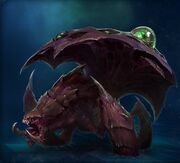
A swarm host
The swarm host (otherwise known as the "egg monster" by terrans)[1] is a zerg strain in StarCraft II: Heart of the Swarm.
Overview
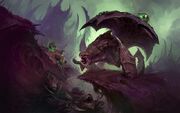
A swarm host spawning locusts
Generated by the infestation pit, the swarm host burrows into the ground in order to provide a seemingly endless supply of locusts.[2] The large, mushroom-shaped structure on the swarm host’s back is a breeding ground that weaponizes the millions of diminute larvae inhabiting the creature’s acidic bloodstream. Through a simple system of membranes for matter exchange, glands that pump the offspring full of hormones to hyper-accelerate growth, and ducts for efficient transportation to the bubbling pockets on the surface of the incubator, the swarm host births deadly, short-lived locusts to destroy threats to the Swarm. The larvae also feed on damaged tissue, sealing wounds, and destroying anything foreign that enters their domain. When the creature is threatened or engaged in combat, a subtle chemical reaction signals the larva to head for the incubator, where they are evolved into living weapons.[3]
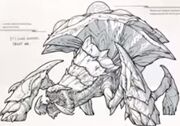
A swarm host
The swarm host is often used in defensive maneuvers.[2] Its legs boast powerful muscles that allow them to vibrate at hypersonic speeds, not unlike the teeth of the nydus worm. Despite that, the creature couldn´t burrow fast enough to adapt to shifting battlefield conditions. To correct this, a set of fragile (albeit regenerating) capillaries was put into place. Now, when the swarm host digs, the capillaries break and the creature’s acid blood softens the soil, allowing it to go underground in seconds. Flexible osseous structures of varying thickness slide and lock into position when the swarm host prepares to strike. Bearing a resemblance to siege tank hydraulics, this specialized skeletal system allows the swarm host to maintain position and balance when spewing locusts or when under heavy fire.[3] The swarm host lacks mobility however, which leaves it vulnerable to quicker enemies with area damage like the hellion. [2]
History
The first swarm hosts encountered by the Swarm were primal zerg on Zerus, used against Kerrigan's forces by the pack leader Brakk.[4] Swarm host strains were incorporated into Kerrigan's Swarm soon afterwards by Abathur, adapted through primal essence.[5]
Recent reports within the Dominion have suggested that swarm hosts have developed the ability to spawn locusts without being burrowed.[1]
During the End War, a number of Swarm hosts came under Amon's control, and were inducted into his brood. They were encountered by Alarak and Vorazun on Aiur. [6]
Game Unit
The swarm host's Summon Locust ability changed dramatically in April 2015. The ability is now manually cast with the hotkey "C", and the cooldown increased to 60 seconds. It can be used whether the swarm host is burrowed or not.[8]
Swarm hosts cannot attack directly.
Many zerg ground units may burrow, becoming invisible and revealed primarily by detectors, and may not move or attack while burrowed.
Exceptions include:
- Roach, which may move while burrowed
- Lurker, which may attack while burrowed
- Infestor, which may move while burrowed
- Baneling, which can detonate while burrowed.
Some units can unburrow via autocast, causing them to emerge and attack when an enemy moves into range.
The ability is not smartcast.
| Usage | ||||
|---|---|---|---|---|
|
| Acquisition | ||||||||
|---|---|---|---|---|---|---|---|---|
|
Upgrades
- +1 bonus to armor per level for zerg ground units.
| Acquisition | ||||||||||||||
|---|---|---|---|---|---|---|---|---|---|---|---|---|---|---|
Level 1
Level 2
Level 3
|
Increases the lifespan of locusts by 10 seconds (to 25 seconds). This upgrade was removed from HotS in the April 2015 update, as the locust's base lifespan was increased to 25 seconds. [9]
This upgrade is not present in Legacy of the Void.[10]
| Acquisition | ||||||
|---|---|---|---|---|---|---|
|
Allows locusts spawned by swarm hosts to fly. Flying locusts can use Swoop to land and attack units.
Automatically available in Legacy of the Void.
| Acquisition | ||||||
|---|---|---|---|---|---|---|
|
Heart of the Swarm Campaign
Swarm hosts appear as primal zerg enemy units in "Waking the Ancient."[4] Afterwards, the player gains access to them in "The Crucible."[5] They have access to a number of upgrades in the evolution pit.[11]
In the campaign swarm hosts function differently. They do not burrow, instead using the root command. While rooted, a swarm host cannot move but is still visible. They do not autocast spawn locusts in the same way as in the multiplayer game. Instead, they only spawn locusts, while rooted, when an enemy comes into range, or the player selects spawn locusts and clicks a location.
Upgrades
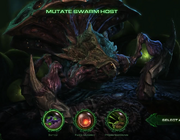
The swarm host upgrade screen
Allows swarm host to burrow. Can still spawn locusts while burrowed.
Primal sequences of swarm host resistant to improvement. Frustrating. Simple adaptations become incredible challenge. Essence constantly adapting, rejecting mutations. Aggravating. Difficult, but can enable burrow. Locust spawning will remain functional while submerged.
| Campaign Acquisition |
|---|
|
|
Locusts spawn 20% faster.
Locust production inefficient. Will greatly benefit from redundancy removal. Sequences are complex, wasteful. Byproduct of wild, uncontrolled evolution. Simplification of sequences will allow swarm hosts to incubate full-grown locusts at rapid speeds.
| Campaign Acquisition |
|---|
|
|
Locusts can attack both ground and air units.
Swarm host defense reliant on locust organism. Locust secrets solvent fluids, projectiles towards enemy. Can mutate glands, increase pressure. Will allow projectile to reach incredible height. Attack both ground and aerial targets.
| Campaign Acquisition |
|---|
|
|
Legacy of the Void
In Legacy of the Void, swarm hosts can produce locusts on the move;[12] this ability is now manually activated.[13] These locusts are more powerful but do not spawn as quickly. In the late game the locusts can fly[12] over terrain. The locusts must then "swoop" to attack.[13]
Swarm hosts now require the burrow ability to be researched for them. They no longer collide with locusts.[7] They can no longer move while burrowed.[14]
Co-op Missions
Abathur is able to mutate swarm hosts in Co-op Missions. He is able to upgrade them when he reaches Level 9.
Abilities
Upgrades
Development
The following section contains information from a previous version of StarCraft II which is no longer valid.
|
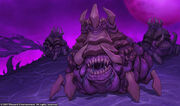
Swarm hosts development image
- Main article: Infestor/Development
The swarm host[15] was expected to be available in the campaign and map editor of StarCraft II.[16] As the swarm host is now, it could have been an aerial unit, but it eventually became a ground one.[17] The idea behind its current design was to give zerg players their own siege unit, but make sure it functioned in a different manner to the siege tank or colossus.[18]
The swarm host's current form was to give the zerg a new aesthetic, something to distinguish the unit from the usual claws and teeth that other zerg units possess.[19]
"Egg monster" and "digester" are terms used for the swarm host in the beta files of Heart of the Swarm.[20]
Variant Strains
References
|
